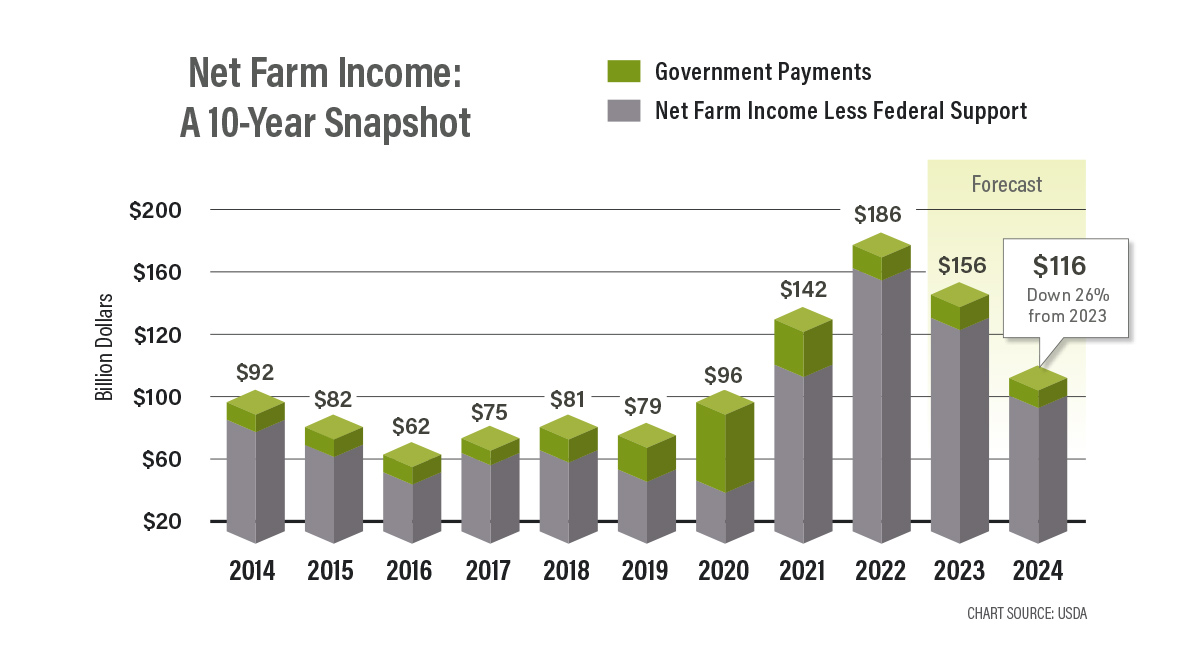Feeling Economic Pressure? Technology Can Help Lessen the Blow
![“Programs can pay $4 to $8 per acre [for on-farm sustainability practices]; that’s new passive income.”](https://cdn.farmjournal.com/s3fs-public/styles/840x600/public/2024-03/Smart-Farming-Feeling-Economic-Pressure.jpg)
Farm Journal’s Smart Farming Week is an annual week-long emphasis on innovation in agriculture. The goal is to encourage you to explore and prioritize the technology, tools and practices that will help you farm smarter. Innovation today ensures an efficient, productive and sustainable tomorrow.
In early February, USDA’s Economic Research Service (ERS) released its 2024 net farm income projections. The numbers were not promising — namely the 26% decline in net farm income year over year. To top it off, there are other red flags for the year.
The American Farm Bureau Federation (AFBF) is projecting net farm income to see the largest year-to-year decrease since the organization began tracking such figures. John Deere has projected a 20% decline in large equipment sales, and economists at the University of Illinois released data showing corn farmers should be prepared to take up to a $160 per acre loss.
According to AFBF, the forecast decline in 2024 net farm income is directly tied to lower crop and livestock cash receipts and continued increases in production costs.
With that said, 2024 is shaping up to be an incredibly challenging operating environment for farmers and the companies that serve them, which includes the technology and machinery segments.

“All the major OEMs are predicting a decline in equipment and technology sales in 2024, anywhere from 6% up to 20%,” says Darryl Matthews, a recently retired Trimble executive.
The good news? Farmers are built for this.
“You put a crop in the ground, and you hope because to some extent you’re going to have weather events, you’re going to have supply chain events — there’s so much uncertainty,” says Viren Popli, president and CEO of Mahindra Ag North America. “It’s our business to deal with it.”
What does worry Popli is the swings, or cycles, seem to be growing more pronounced of late.
“Coupled with high inflation, higher labor costs and [lack of] availability of help — these are big challenges,” Popli adds. “Can we use technology to do some of these tasks easier, better and faster, and save money that way?”
For Matthews, it comes down to this double-edged sword: Farmers might be reluctant to part with hard-earned dollars in a depressed farm economy, yet technology is the tool that can help them better weather the storm.
“It’s in these challenging markets farmers need to think about driving more efficiency using technology,” he says.
Machine guidance is a great place to start. Matthews notes GPS and guidance technology have already achieved 80% market penetration in North America. Now would be a good time to pick up that last 20%, though.
“Guidance can pay $15 an acre, on average, in corn production back to a farmer in less overlap, less fuel and less inputs,” Matthews says. “At 650 acres and $15 an acre, guidance is going to pay for itself in one year, and typically those systems will last seven years.”
Another potential revenue stream Matthews advises farmers to take a closer look at is programs that pay for on-farm sustainability practices.
“Those programs can pay $4 to $8 per acre; that’s new passive income few farmers are signing up for,” he says. “If you’re farming 1,600 acres or more, those programs can bring in $10,000 you can use on technology and bring more efficiency into your operation.”
Ultimately the choice to invest or sit out the year from a buying standpoint rests with each farmer. Matthews recommends leaning on trusted partners to help navigate these choppy waters.
“I’d bring in your ag retailer and farm equipment dealer when deciding where you’re trying to go and have an honest conversation,” he says. “Variable-rate seeding and nutrients are another area where you can get about $20 per acre savings in corn production.”
Want to read more about farming smarter?
Prioritize Technology That Works For You So You Can Farm Smarter
Make Every Bushel and Penny Count
Are Used Combine Values On the Decline?
5 Trends To Watch In The Input Market







